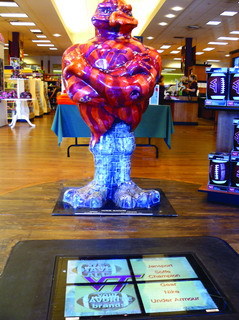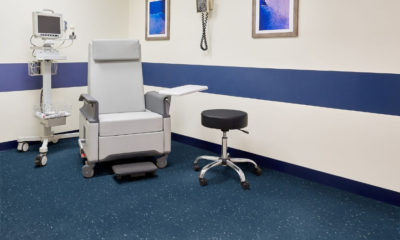Can retailers get “more from the floor” by utilizing digital signage screens that are mounted underfoot? University Bookstores at Virginia Polytechnic and State University is exploring that question with an on-the-floor digital signage (FDS) system by IntelliMat (Roanoke, Va.) at three of its stores on and near the Blacksburg, Va., campus. Steven Keith Platt, director of the Platt Retail Institute, recently spoke with Donald Williams, the bookstores’ executive director, about that installation.
Describe the FDS.
We have been testing three FDS units, one in each of our two large bookstores, as well as one in our convenience store, for about a year. The FDS is a wireless computer with four LCD screens that form one image embedded in a thin mat lying flat on the floor, resulting in a 30-inch diagonal display. The player is integrated into the unit. Installation consists of laying the FDS on the floor and plugging it in.
Where have you placed the units?
Near higher-margin products, such as apparel and gifts.
Why FDS, instead of a wall unit or other off-floor digital signage?
Ease of installation, for one. And the ability to move the FDS around the store was also very important.
What kind of results have you realized from your investment in FDS?
The results have been positive, but it also presents us with challenges that we need to address. We experimented to see if we could influence purchase behavior in several ways. In one instance, we offered free mugs on the screen, requiring the student to ask for a mug at a different location in the store. We quickly ran out of free merchandise. In addition, we have noticed increased sales of promoted products, such as higher-end apparel. But the biggest challenge is creating relevant content that is integrated with our overall marketing program.
Tell us about your content strategy. How do you execute it?
We generally coordinate with our marketing department, which supports our retail operations, on overall direction. So it tends to be event-driven (such as, say, stressing football), but it is also product-focused. Most of our content is developed internally, but we also use outside resources. We run approximately 4- to 5-minute loops of six or seven messages. Of those messages, four are product-promotional and the balance are general format, such as clips of a football game.
That translates into 30 to 60 seconds per spot, which seems like a long message. It raises questions about visibility and dwell time. What has been your experience in those two areas?
When it comes to visibility, we know that our customers notice the messages because we see the results they’ve achieved. If the FDS is located near product, it will hold the customer’s attention. There is also a novelty factor associated with the FDS that attracts people to it. The ease of transporting the FDS also enables us to ensure that students are exposed to it and, of course, its messaging. In regard to dwell times, our experience indicates that people tend to stop and watch the programming. We believe that the eye-catching nature of the display results in our customer, especially the younger clientele, actually stopping and noticing the FDS.


 Photo Gallery1 week ago
Photo Gallery1 week ago
 Headlines7 days ago
Headlines7 days ago
 Headlines1 week ago
Headlines1 week ago
 Headlines2 weeks ago
Headlines2 weeks ago
 Headlines1 week ago
Headlines1 week ago
 Designer Dozen2 weeks ago
Designer Dozen2 weeks ago
 Designer Dozen5 days ago
Designer Dozen5 days ago
 Headlines7 days ago
Headlines7 days ago













